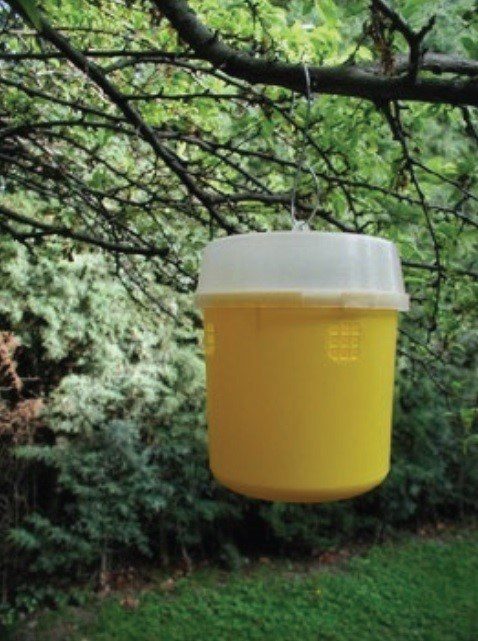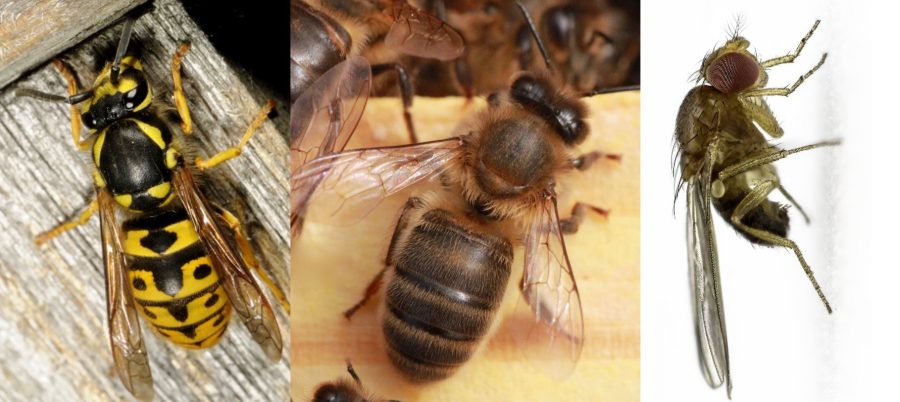News Plant Pest(s): The Oriental fruit fly Bactrocera dorsalis
In Belgium, larvae of the Oriental fruit fly (i.e. maggots) are regularly intercepted during inspections of imported fruit and vegetables from African countries. This fly, which belongs to the family Tephritidae (Diptera) and was once described in Plant attackers in 2020, is a priority quarantine pest in the European Union (Figure 1). This means that the EU wants to avoid the introduction of this fly at all costs because of the risk of major economic damage in European fruit and vegetable production. If the intercepted larvae are identified, a.o. by ILVO, as Oriental fruit fly, the infected batches of fruit or vegetables are destroyed to prevent further spread. In 2023, however, adult flies were found for the first time in Belgium, which is why this Plant attacker is being highlighted here again, with the focus now on the adults, the flies.

In recent years, there had been reports of adult Oriental fruit flies in Austria, France and Italy, but not yet in more northern European countries such as Belgium. Until August 2023, at a public fruit and vegetable market in the centre of Antwerp, a male specimen of the Oriental fruit fly was caught in a trap. One of the most commonly used traps is the Tephri-Trap® (Figure 2). This is a funnel trap consisting of two parts: a yellow base containing three circular openings through which the flies fly into the trap and a transparent lid. This trap also contains an attractant (pheromone) that attracts the flies and a preservative (monopropylene glycol) that kills the trapped flies.

This trap had thus been hung as part of an annual monitoring by the Federal Agency for the Safety of the Food Chain (FASFC) and it was suspected that this fruit fly had escaped from a batch of imported exotic fruits at or near the market. Following this finding, additional traps were hung around the market and sites with host plants were inspected in the wider area. An appeal was also made to wholesalers of fruits and vegetables, as well as citizens, to be alert for the Oriental fruit fly. Just a few weeks later, two adult flies were again caught in public markets. Remarkably, this find happened 50 and 100 km from the first detection site. Moreover, four more adult flies were found in Antwerp, but this time in different locations, including community gardens.
The most plausible explanation for the presence of Oriental fruit flies in public markets in Belgium is that the fruit flies travelled as eggs or larvae with imported fruits, mainly mango and sweet pepper. However, it is noteworthy that adults were found almost simultaneously at three different and relatively distant locations. Moreover, flies in Antwerp were also found in locations not immediately close to a market. Meanwhile, based on genetic analyses, the Royal Museum of Central Africa was able to determine that the captured Oriental fruit flies did not all originate from the same region in Africa, probably indicating multiple independent introductions to our country. It is important to find out exactly where these flies come from, as this will allow us to identify countries that pose a high risk of exporting this pest along with batches of fruits. Thus, we can then develop a more effective strategy to combat the introduction and spread of this fruit fly in our country.
The various findings also suggest that such introductions will be more frequent in the future. Therefore, extra vigilance is needed, both by the FASFC, the exotic imported fruit industry and the general public. Increased vigilance can be obtained by placing more traps near markets or wholesale companies and by monitoring more locations linked to fruit waste processing, such as composting companies.
Besides setting more traps or monitoring additional locations, citizens could also be involved in early detection of unwanted fruit flies in their compost heaps. ILVO submitted an application for such a Citizen Science project, and hopefully we can effectively start working on this later this year. In that case, of course, it is important that everyone is able to distinguish the Oriental fruit fly from other flies or insects, but fortunately this is not too bad (Figure 1). The adult Oriental fruit fly is a small fly (length: 6-8 mm) and can be recognised by:
1) the two yellow stripes on the edges of their thorax
2) the black border on the edge of their wings
3) the T-shaped pattern on their abdomen

Oriental fruit flies could be confused with wasps, but these are larger and, unlike fruit flies, have 2 pairs of wings (Figure 3). In turn, bees are strongly hairy, while this is not the case in the Oriental fruit fly. In addition, there could possibly be name confusion with the Asian fruit fly, Drosophila suzukii. However, adults of the latter are much smaller (2-3.5 mm) and outwardly totally different from the Oriental fruit fly. Moreover, contrary to what its name suggests, the Asian fruit fly is not a quarantine pest.
If you should find this fly yourself around your fruit trees or compost heap, take a photo and report the find to the FASFC at meldpunt@favv.be. If necessary, even try to catch them in a jar. On the basis of these reports, the FASFC can get a better and faster overview as to the frequency with which these pests enter our country and, consequently, take faster measures to prevent such introductions.
 Diagnostic Centre for Plants
Diagnostic Centre for Plants